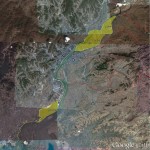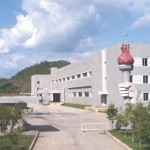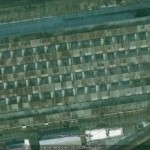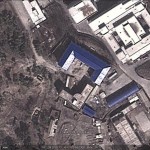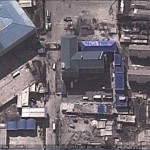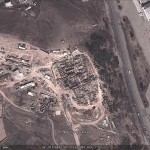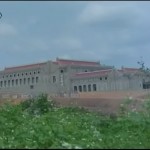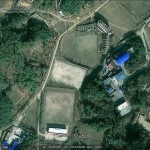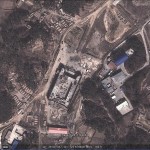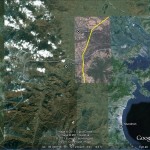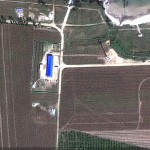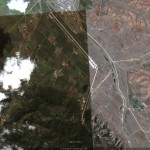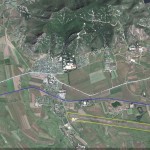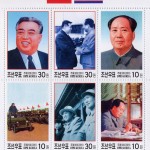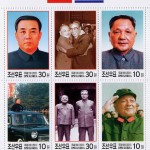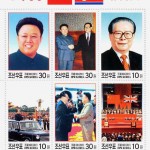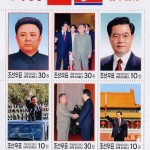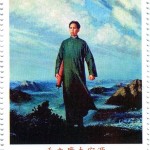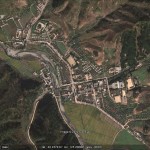
Pictured above (Google Earth) is Changsong Town in North Pyongan Province. This town is the home of the Changsong Joint Conference which was held in August 1962. This meeting was referenced in the DPRK’s most recent Cabinet plenary meeting on the DPRK economy.
According to KCNA (2012-1-22):
An enlarged Cabinet plenary meeting was held.
Present there were Premier Choe Yong Rim and cabinet members.
Attending the meeting as observers were senior officials of the organizations under direct control of the Cabinet, directors of management bureaus, chairpersons of provincial, city and county people’s committees, chairpersons of provincial rural economy committees, chairpersons of provincial planning committees, directors of provincial foodstuff and daily necessities management bureaus and managers of major factories and enterprises.
Prior to the meeting, the participants paid silent tribute to the memory of leader Kim Jong Il.
The meeting reviewed the fulfillment of last year’s national economic plan and discussed how to implement the decision of the Political Bureau of the Central Committee of the Workers’ Party of Korea, joint calls of the WPK Central Committee and the Central Military Commission and the militant task put forward in the joint New Year editorial.
Vice-Premier Ro Tu Chol made a report to be followed by speeches.
The enlarged meeting set it as a priority task for this year to direct efforts into developing light industry and agriculture to improve the people’s livelihood and successfully carrying out the WPK’s prosperity-oriented strategy in the pilot domains and basic industries of the national economy upholding the flames of South Hamgyong Province. It also indicated the tasks and ways for it.
Also discussed was an issue of raising higher the flames of great innovation of South Hamgyong Province in the light industrial and agricultural fields.
The meeting mentioned the need to produce quality consumer goods favored by the people in the field of light industry and effect a decisive turn in development of local industry this year marking the 50th anniversary of the historic Changsong joint conference.
It also stressed the need for ministries and national institutions to help Changsong County in its industrial development.
Also discussed at the meeting were such issues as fulfilling the assignments for grain production for 2012 both in lowland and mountainous areas, making the best use of modern stockbreeding and poultry bases and large fruit and fish farms as well as the tasks for ministries and national institutions to preferentially supply materials, equipment and electricity to farming processes.
The meeting drew attention to the tasks for the industrial fields of electric power, coal, metal, railways and machine and construction and building materials, etc.
The meeting tabled the tasks for all ministries, national institutions and provincial people’s committees to lay their own scientific and technological foundations for stepping up the work for turning the economy into one based on technology in a forward-looking manner as required by the industrial revolution in the new century.
It also discussed the tasks for the fields of education, literature and art, public health, sports, capital construction, land management and urban management.
The meeting stressed the need for all economic officials to preserve the socialist principle and ensure profitability in economic management, operate and manage the economic work on the basis of detailed calculation and science as well as the need for ministries, national institutions and industrial establishments to set up strict order regarding planning, financial dealings and administration.
Relevant decisions were made at the meeting.
As premier of the Cabinet Choe Yong-rim has made quite a few prominent appearances in the DPRK media in the last two years which highlight his official efforts to improve the North Korean economy. His most recent public appearance (January 12) is reported to have been at the Jenam Coal Mine.
Kim Jong-un, however, is not a member of the Cabinet, so he did not attend the meeting. To date his legitimacy is being established through his relationship to Kim Jong-il/Kim Il-sung and as a leader of the KPA—rather than as a leader in the government or even the party (at least so far).
As a result, Kim Jong-un’s guidance visits have consisted almost exclusively of visits to KPA units. In this month alone, he has visited the 105 Tank Brigade, KPA Unit 169, KPA Unit 3870, KPA Unit 354, KPA Unit 671, and the KPA soldiers constructing the Pyongyang Folk Village on the outskirts of Pyongyang. Uriminzokkiri has also credited him with spearheading the DPRK’s nuclear tests.
UPDATE: Here is Yonhap coverage of the meeting.
“Changsong Joint Conference”
The KCNA article prompted me to look into the “Changsong Joint Conference”, a term that did not ring a bell. The most recent reference I can find to it is this blurb from a March 2011 article in Korea Magazine:
The Changsong Joint Conference of Local Party and Economic Officials was held in August 1962.
The conference marked the beginning of developing the local industry throughout the country.
In recent years the county has made strenuous efforts to carry out the plan of the Workers’ Party of Korea for the building of a thriving nation and achieved many successes.
Hundreds of hectares of forests of raw materials and timber forests including pine-nut, wild-walnut and larch forests have been newly created.
The Changsong Foodstuff Factory gathers in scores of kinds of wild fruits including acorns, wild grapes, fruits of Actinidia arguta and Crataegus pinnatifida every year in mountains.
Recently its officials and workers have modernized all production processes including wild fruit drinks and wines as required in the IT age to produce foodstuffs in time.
Wines made from the fermented juice of wild grapes, fruits of Actinidia arguta and other wild fruits, Crataegus pinnatifida, Rubus crataegifolius, carbonated Actinidia arguta and other fruit juices, dried bracken and sliced bracken and other wild vegetables preserved in soy sauce are in great demand for their peculiar flavour.
The Changsong Textile Mill which started operation with six housewives has been turned into a modern fabric producer. As a treasure mill, it makes a great contribution to the improvement of the people’s standard of living. It produces quality fabrics, woolen knitted goods and quilts and blankets with local raw materials.
The Changsong Paper Mill produces paper from ground pulp. It has streamlined the equipment to improve the qualities of goods.
Looking round the local-industry factories in Changsong County in November last year, Kim Jong Il kindled the flame of developing the local industry throughout the country after the model of Changsong.
Changsong County stands at the head of development of local industry. Now its people work harder to change further the looks of their home village.
Another blogger seems to have located a single page of a book on the Changsong Joint Conference. Fortunately, he typed out the introduction:
The great leader Comrade Kim Il Sung had made a farsighted plan for bridging the gap between town and country and between regions and raising equally the living standards of all the working people. For this Changsong County had been taken as a model.
The great leader who had long pushed preparations for rapid improvement in the livelihood of the mountain peasants, studied deeply the state of affairs in this part of the country, and through his several on-the-spot guidances, paved the shortest cut to establish a socialist paradise.
In August 1962, in order to spread the example of Changsong across the land he convened the historic Changsong Joint Conference of Local Party and Economic Functionaries. There he put forward a new policy and overall ways and means to enhance the role of the county and develop local industry and agriculture, so as to improve radically the people’s living conditions.
In 1974, our people erected in Changsong the historic monument to the on-the-spot guidance of the respected and beloved leader Comrade Kim Il Sung, out of their wish to retell throughout generations the profound care of the fatherly leader who had shown the bright future of mountain villages and transformed that area into a people’s paradise fine to live in.
Kim Jong-il last visited Changsong in November 2010 where he visited the Changsong Foodstuff Factory, Changsong Textile Mill, and Changsong House of Culture. The first two locations are the shining examples of the success of the Changsong Joint Conference. The Changsong House of Culture is where the meeting was officially held in 1962.
But if the goal of the conference is to reduce the disparity in the DPRK’s living standards, Changsong is probably not the best place to start. Changsong is home to one of the North Korean leadership’s most well-known luxury retreats. This is because it was was extensively photographed by Kenji Fujimoto while he was working as Kim Jong-il’s personal chef. See a satellite image and Mr. Fujimoto’s pictures of the compound here. You can see the Taegwan leadership train station Kim used to visit the compound here.
